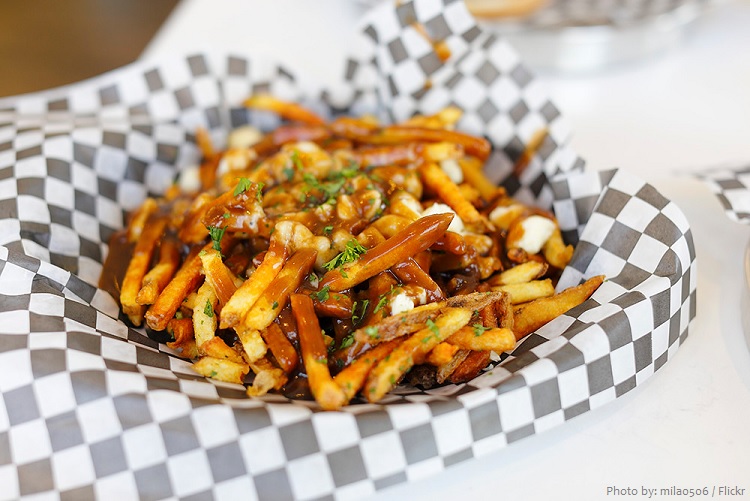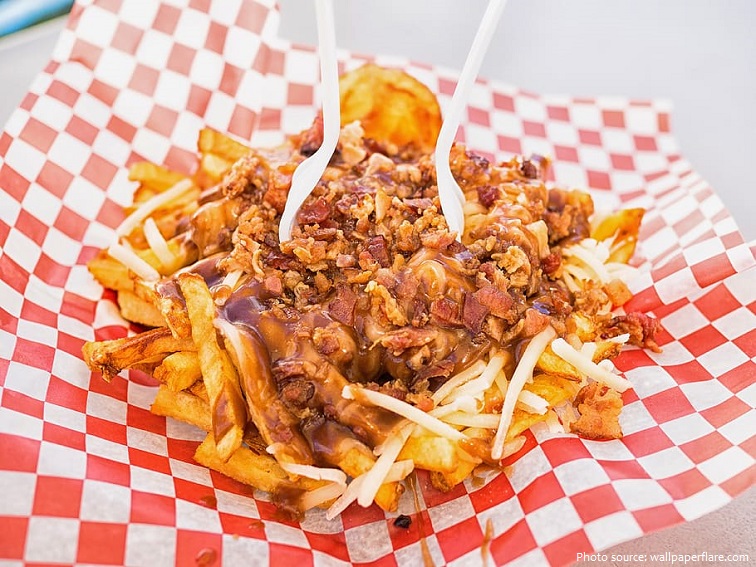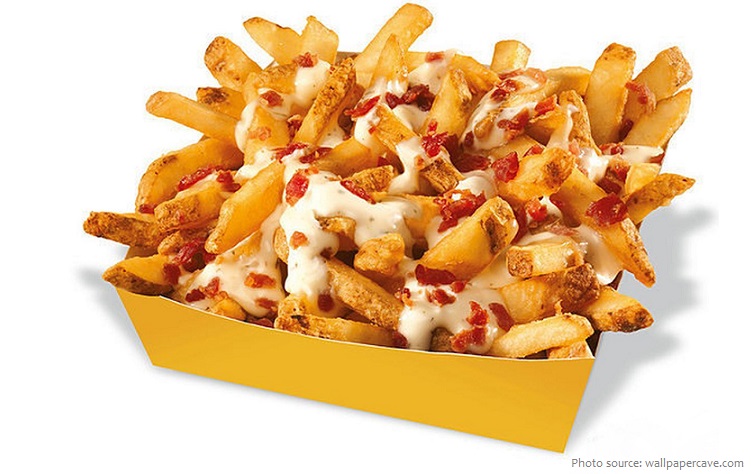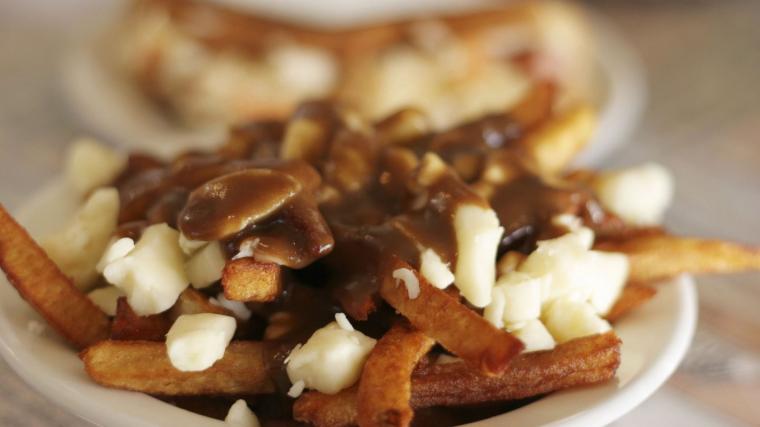
Poutine is a dish of french fries and cheese curds topped with a brown gravy.
While poutine is now available at fine restaurants and fast-food chains alike, it was completely unknown in the mid-20th century.
The combination of fresh-cut fries, cheese curds and gravy first appeared in rural Quebec snack bars in the late 1950s. Though the precise origins of poutine are much debated, in most cases, the dish was developed in stages.

Several restaurants in the area claim to be the originators of the dish, but no consensus exists.
• Le Lutin qui rit, Warwick – Restaurateur Fernand Lachance of Le Café Ideal, is said to have exclaimed in 1957, “ça va faire une maudite poutine!” (English: “It will make a damn mess!”) when asked by a regular to put a handful of cheese curds in a take-out bag of french fries. The dish “poutine” appears on the establishment’s 1957 menu. Lachance served this on a plate, and beginning in 1962 added hot gravy to keep it warm.
• Le Roy Jucep, Drummondville – This drive-in restaurant served french fries with gravy, to which some customers would add a side order of cheese curds. Owner Jean-Paul Roy began serving the combination in 1958 and added it to the menu in 1964 as “fromage-patate-sauce”. Felt to be too long a name, this was later changed to poutine for a cook nicknamed “Ti-Pout” and a slang word for “pudding”. The restaurant displays a copyright registration certificate, issued by the Canadian Intellectual Property Office, which alludes to Roy having invented poutine.
• La Petite Vache, Princeville – Customers would mix cheese curds with their fries, a combination which was added to the menu. One option included gravy and was called the “Mixte”.

Eventually, poutine spread across Québec and throughout Canada — with different combinations added to the fries, curds, and gravy recipe — but the original remains the most recognized and honored. The dish has become so ubiquitous in its home province that even McDonald’s and Burger King sell it as a side.
For many years it was perceived negatively and mocked, and even used by some to stigmatize Quebec society. Poutine later became celebrated as a symbol of Québécois culture and the province of Quebec. Its rise in prominence has led to popularity throughout the rest of Canada, and internationally.
As poutine’s popularity spread, various iterations began to appear, such as Italian poutine (made with spaghetti sauce or sausage in place of gravy), veggie poutine (made with mushroom sauce and vegetables) and Irish poutine (made with lardons). Regional variations included la galvaude from Gaspésie, prepared with chicken and green peas, and Montreal-style poutine, made with smoked meat, to name but two.

Poutine is found in the northern border regions of the United States, including New England and the larger Northeast, the Pacific Northwest, and the Upper Midwest. These regions offer further variations of the basic dish, usually by utilizing cheeses other than fresh curds, which are not widely available in the US. In the country culture, a mixed fry can also come with cooked ground beef on top and is referred to as a hamburger mix, though this is less popular than a regular mix. In the Pacific Northwest, one variation replaces the gravy with chowder featuring local seafood.
Poutine made the leap from a fast-food offering onto the menus of high-end restaurants, when spots like Montreal’s Au Pied de Cochon started serving up poutine topped with foie gras in 2002. Other luxe varieties that have sprung up include chef Chuck Hughes’ competition-winning lobster poutine on Iron Chef, now served at his restaurant Garde Manger, and fries layered with triple-A steak, truffles, and red wine demi-glaze at Pub Quartier Latin.

Annual poutine celebrations occur in Montreal, Quebec City, and Drummondville, as well as Toronto, Ottawa, New Hampshire and Chicago. It has been called “Canada’s national dish”, though some believe this labelling represents cultural appropriation of the Québécois or Quebec’s national identity.
While the exact provenance of poutine remains contested, its birthplace is unquestionably Quebec.
The word “poutine” is commonly believed to have originated from the English word pudding (or as it were in French, pouding) used to describe a mixture, typically messy, of various foods. In Québec, the term poutine is slang for mess. More than a dozen other explanations have been offered, including the root of the French words potin (pâté) and poutitè (potato ragout).

The traditional recipe for poutine consists of:
• French fries: These are usually of medium thickness and fried (often twice) such that the inside stays soft, while the outside is crispy.
• Cheese curds: Fresh cheese curds are used to give the desired texture. The curd size varies, as does the amount used.
• Brown gravy: Traditionally, it is a light and thin chicken gravy, somewhat salty and mildly spiced with a hint of pepper – or a sauce brune, which is a combination of chicken and beef stock. Poutine sauces (mélange à sauce poutine) are sold in Quebec, Ontario, and Maritime grocery stores in jars or cans and in powdered mix packets – some grocery chains offer their own house-brand versions. Many stores and restaurants also offer vegetarian gravy.
The largest serving of poutine measured 3034 kg (6688.82 lb), and was achieved by Les Fromages de Warwick (Canada), in Warwick, Canada, on 3 August 2019.